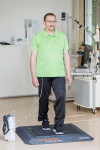Whole-body vibration training versus conventional balance training in patients with severe COPD-a randomized, controlled trial
- PMID: 33947416
- PMCID: PMC8097810
- DOI: 10.1186/s12931-021-01688-x
Whole-body vibration training versus conventional balance training in patients with severe COPD-a randomized, controlled trial
Abstract
Background: Whole-body vibration training (WBV) performed on a vibration platform can significantly improve physical performance in patients with chronic obstructive pulmonary disease. It has been suggested that an important mechanism of this improvement is based on an improvement in balance. Therefore, the aim of this study was to investigate the effects of WBV compared to conventional balance training.
Methods: 48 patients with severe COPD (FEV1: 37 ± 7%predicted) and low exercise performance (6 min walk distance (6MWD): 55 ± 10%predicted) were included in this randomized controlled trial during a 3 week inpatient pulmonary rehabilitation. All patients completed a standardized endurance and strength training program. Additionally, patients performed 4 different balance exercises 3x/week for 2 sets of 1 min each, either on a vibration platform (Galileo) at varying frequencies (5-26 Hz) (WBV) or on a conventional balance board (BAL). The primary outcome parameter was the change in balance performance during a semi tandem stance with closed eyes assessed on a force measurement platform. Muscular power during a countermovement jump, the 6MWD, and 4 m gait speed test (4MGST) were secondary outcomes. Non-parametric tests were used for statistical analyses.
Results: Static balance performance improved significantly more (p = 0.032) in favor of WBV (path length during semi-tandem stand: - 168 ± 231 mm vs. + 1 ± 234 mm). Muscular power also increased significantly more (p = 0.001) in the WBV group (+ 2.3 ± 2.5 W/kg vs. - 0.1 ± 2.0 W/kg). 6MWD improved to a similar extent in both groups (WBV: 48 ± 46 m, p < 0.001 vs. BAL: 38 ± 32 m; p < 0.001) whereas the 4MGST increased significantly only in the WBV-group (0.08 ± 0.14 m/s2, p = 0.018 vs. 0.01 ± 0.11 m/s2, p = 0.71).
Conclusions: WBV can improve balance performance and muscular power significantly more compared to conventional balance training.
Trial registration: Clinical-Trials registration number: NCT03157986; date of registration: May 17, 2017. https://clinicaltrials.gov/ct2/results?cond=&term=NCT03157986&cntry=&state=&city=&dist = .
Keywords: Chronic obstructive pulmonary disease; Exercise; Force measurement platform; Neuromuscular power; Pulmonary rehabilitation; Vibration platform.
Conflict of interest statement
The authors declare that they have no competing interests.
Figures




Similar articles
-
What's the secret behind the benefits of whole-body vibration training in patients with COPD? A randomized, controlled trial.Respir Med. 2017 May;126:17-24. doi: 10.1016/j.rmed.2017.03.014. Epub 2017 Mar 14. Respir Med. 2017. PMID: 28427544 Clinical Trial.
-
Effects of whole body vibration in patients with chronic obstructive pulmonary disease--a randomized controlled trial.Respir Med. 2012 Jan;106(1):75-83. doi: 10.1016/j.rmed.2011.10.021. Epub 2011 Nov 21. Respir Med. 2012. PMID: 22104540 Clinical Trial.
-
Whole-body vibration improves functional capacity and quality of life in patients with severe chronic obstructive pulmonary disease (COPD): a pilot study.Int J Chron Obstruct Pulmon Dis. 2015 Jan 12;10:125-32. doi: 10.2147/COPD.S73751. eCollection 2015. Int J Chron Obstruct Pulmon Dis. 2015. PMID: 25624756 Free PMC article. Clinical Trial.
-
Does Whole-Body Vibration Improve the Functional Exercise Capacity of Subjects With COPD? A Meta-Analysis.Respir Care. 2016 Nov;61(11):1552-1559. doi: 10.4187/respcare.04763. Epub 2016 Sep 20. Respir Care. 2016. PMID: 27651524 Review.
-
Long-Term Effects of Whole-Body Vibration on Human Gait: A Systematic Review and Meta-Analysis.Front Neurol. 2019 Jun 19;10:627. doi: 10.3389/fneur.2019.00627. eCollection 2019. Front Neurol. 2019. PMID: 31316447 Free PMC article.
Cited by
-
Whole Body Vibration: A Valid Alternative Strategy to Exercise?J Funct Morphol Kinesiol. 2022 Nov 3;7(4):99. doi: 10.3390/jfmk7040099. J Funct Morphol Kinesiol. 2022. PMID: 36412761 Free PMC article. Review.
-
High-intensity non-invasive ventilation during exercise-training versus without in people with very severe COPD and chronic hypercapnic respiratory failure: a randomised controlled trial.BMJ Open Respir Res. 2023 Nov 22;10(1):e001913. doi: 10.1136/bmjresp-2023-001913. BMJ Open Respir Res. 2023. PMID: 37993279 Free PMC article. Clinical Trial.
-
European Respiratory Society International Congress 2020: highlights from best-abstract awardees.Breathe (Sheff). 2020 Dec;16(4):200270. doi: 10.1183/20734735.0270-2020. Breathe (Sheff). 2020. PMID: 33664840 Free PMC article.
-
Updated Perspectives on the Role of Biomechanics in COPD: Considerations for the Clinician.Int J Chron Obstruct Pulmon Dis. 2022 Oct 17;17:2653-2675. doi: 10.2147/COPD.S339195. eCollection 2022. Int J Chron Obstruct Pulmon Dis. 2022. PMID: 36274993 Free PMC article. Review.
-
Exercise-based interventions targeting balance and falls in people with COPD: a systematic review and meta-analysis.Eur Respir Rev. 2024 Jun 26;33(172):240003. doi: 10.1183/16000617.0003-2024. Print 2024 Apr. Eur Respir Rev. 2024. PMID: 38925795 Free PMC article.
References
-
- Abercromby AF, Amonette WE, Layne CS, McFarlin BK, Hinman MR, Paloski WH. Variation in neuromuscular responses during acute whole-body vibration exercise. Med Sci Sports Exerc. 2007;39(1642):1650. - PubMed
-
- Ritzmann R, Kramer A, Gruber M, Gollhofer A, Taube W. EMG activity during whole body vibration: motion artifacts or stretch reflexes? Eur J Appl Physiol. 2010;110(143):151. - PubMed
Publication types
MeSH terms
Associated data
LinkOut - more resources
Full Text Sources
Medical

